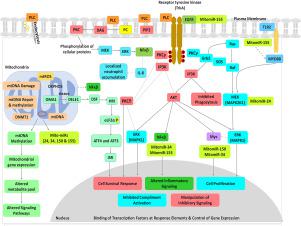Cellular Signalling ( IF 4.4 ) Pub Date : 2020-09-08 , DOI: 10.1016/j.cellsig.2020.109776 Neha Bunkar 1 , Jahnavi Sharma 1 , Anju Chouksey 1 , Roshani Kumari 1 , Pushpendra Kumar Gupta 1 , Rajnarayan Tiwari 1 , Lalit Lodhi 1 , Rupesh Kumar Srivastava 2 , Arpit Bhargava 1 , Pradyumna Kumar Mishra 1

|
Clostridium perfringens, a rod-shaped, gram-positive, anaerobic, spore-forming bacterium is one of the most widely occurring bacterial pathogens, associated with a spectrum of diseases in humans. A major virulence factor during its infection is the enzyme phospholipase C encoded by the plc gene, known as Clostridium perfringens phospholipase C (CpPLC). The present study was designed to understand the role of CpPLC in inducing survival mechanisms and mitochondrial-induced epigenetic changes in a human lymphocyte cell culture model. Following exposure to CpPLC, a significant generation of mitochondrial reactive oxygen species was observed, which coincided with the changes in the expression of vital components of MAP/ERK/RTK signaling cascade that regulates the downstream cellular functions. These disturbances further led to alterations in the mitochondrial genome and functioning. This was supported by the observed upregulation in the expression of mitochondrial fission genes Drp1, Fis1, and Mff, and mitochondrial fusion genes MFN1, MFN2, and OPA1 following CpPLC exposure. CpPLC exposed cells showed upregulation of OMA1, DELE1, and HRI genes involved in the integrated stress response (ISR), which suggests that it may induce the ISR that provides a pro-survival mechanism to the host cell. CpPLC also initiated immune patho-physiologic mechanisms including mitochondrial-induced epigenetic modifications through a mitochondrial-ROS driven signaling pathway. Interestingly, epigenetic machinery not only play a pivotal role in lymphocyte homeostasis by contributing to cell-fate decisions but thought to be one of the mechanisms by which intracellular pathogens survive within the host cells. Importantly, the impairment of mtDNA repair among the CpPLC exposed cells, induced alterations within mtDNA methylation, and led to the deregulation of MT-CO1, MT-ND6, MT-ATPase 6, and MT-ATPase8 gene expression profiles that are important for mitochondrial bioenergetics and subsequent metabolic pathways. This was further confirmed by the changes in the activity of mitochondrial electron chain complexes (complex I, II, III, IV and V). The altered mtDNA methylation profile was also found to be closely associated with the varied expression of mitomiRs and their targets. CpPLC exposed cells showed up-regulation of miR24 expression and down-regulation of miR34a, miR150, and miR155, while the increased expression of mitomiR target genes i.e. of K-Ras, MYC, EGFR, and NF-kβ was also observed in these cells. Altogether, our findings provide novel insights into the derailment of redox signaling machinery in CpPLC treated lymphocytes and its role in the induction of survival mechanisms and mitochondrial-induced epigenetic modifications.
中文翻译:

产气荚膜梭菌磷脂酶 C 通过诱导综合应激反应和线粒体诱导的表观遗传修饰来损害先天免疫反应。
产气荚膜梭菌是一种杆状、革兰氏阳性、厌氧、产芽孢的细菌,是最广泛发生的细菌病原体之一,与人类的一系列疾病有关。其感染期间的主要毒力因子是由plc基因编码的磷脂酶 C ,称为产气荚膜梭菌磷脂酶 C (CpPLC)。本研究旨在了解 CpPLC 在诱导人类淋巴细胞细胞培养模型中的存活机制和线粒体诱导的表观遗传变化中的作用。暴露于 CpPLC 后,观察到线粒体活性氧的显着产生,这与调节下游细胞功能的 MAP/ERK/RTK 信号级联的重要成分表达的变化相吻合。这些干扰进一步导致线粒体基因组和功能的改变。在 CpPLC 暴露后观察到的线粒体裂变基因 Drp1、Fis1 和 Mff 以及线粒体融合基因 MFN1、MFN2 和 OPA1 的表达上调支持了这一点。CpPLC 暴露的细胞显示 OMA1、DELE1、和参与综合应激反应 (ISR) 的 HRI 基因,这表明它可能诱导 ISR,为宿主细胞提供促生存机制。CpPLC 还通过线粒体-ROS 驱动的信号通路启动了免疫病理生理机制,包括线粒体诱导的表观遗传修饰。有趣的是,表观遗传机制不仅通过促进细胞命运决定在淋巴细胞稳态中发挥关键作用,而且被认为是细胞内病原体在宿主细胞内存活的机制之一。重要的是,CpPLC 暴露细胞中的 mtDNA 修复受损,诱导了 mtDNA 甲基化的改变,并导致 MT-CO1、MT-ND6、MT-ATPase 6、和 MT-ATPase8 基因表达谱,这对线粒体生物能量学和随后的代谢途径很重要。线粒体电子链复合物(复合物 I、II、III、IV 和 V)活性的变化进一步证实了这一点。还发现改变的 mtDNA 甲基化谱与 mitomiRs 及其靶标的不同表达密切相关。CpPLC 暴露的细胞显示出 miR24 表达上调和 miR34a、miR150 和 miR155 下调,同时在这些细胞中也观察到 mitomiR 靶基因,即 K-Ras、MYC、EGFR 和 NF-kβ 的表达增加. 共,











































 京公网安备 11010802027423号
京公网安备 11010802027423号